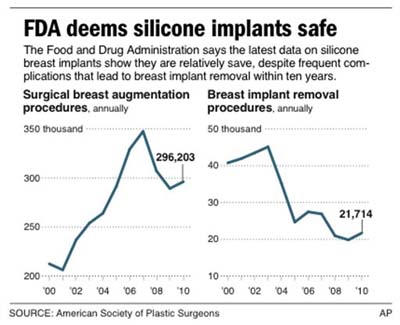The Evolution of Silicone Breast Implants
![]() The silicone gel used to fill implants has changed in the more than forty years since it was first introduced, as have the coverings (what we call the shells). You may be curious about the silicone we use today. You may not realize that there are three consistencies in the current fourth-generation implants.
The silicone gel used to fill implants has changed in the more than forty years since it was first introduced, as have the coverings (what we call the shells). You may be curious about the silicone we use today. You may not realize that there are three consistencies in the current fourth-generation implants.
Phase 1 implants, 1970s
The original silicone breast implants had solid silicone shells and thick silicone gel inside. They were teardrop shaped and patches on the back to keep the implant in place. They were not particularly soft and 100% of the patients developed hard breasts (capsular contractures). Today, we believe it was the immobility of the implant that caused the contractures.
Phase 2 implants, 1980s
Women wanted softer breasts, so they removed the patches and introduced implants with thinner outer covering and more fluid-like gel fill. It turned out that the thinner shells “bled” silicone into the pocket of scar tissue that surrounded the implants. Problems occurred if the scar tissue tore, either as the result of an accident or the surgeon squeezing the breast to break up the scar tissue.
In these cases, the free silicone was forced into the surrounding tissues, where it would become embedded and impossible to remove. In rare circumstances, the body’s immune system would transport microscopic amounts of silicone into other parts of the body.
Phase 3 implants, 1990s
Starting in the 1990s, manufacturers strengthened the shells, but they still “bled” silicone. The gel was similar to the Phase 2 implants.
 Phase 4 implants, 2000s
Phase 4 implants, 2000s
This is what we use today. The shells are now “low bleed” (very little silicone gets through them). The gel inside is “cohesive” (stickier). There are three consistencies, each slightly stickier than the last. In general use today, the least cohesive gel is used because it produces the softest breast.
The most cohesive gel is called “form stable” and popularly known as “gummy bears.” It maintains its teardrop shape in any position. It has been used in Europe for many years, and the first implants using this form stable silicone gel were approved by the FDA for use in the United States in 2012.
Get your recommended breast implant screenings at LJC
At LJC, we want you to enjoy beautiful results and peace of mind! We now offer high-resolution ultrasound imaging to screen silicone breast implants.
Why ultrasound? It’s safe, comfortable, and more affordable than MRI while providing reliable detection of silent rupture, seroma, and other issues. Learn more »
The Keller Funnel, 2010
The Keller Funnel is a soft, sterile, cone-shaped device made from plastic that assists in the delivery of silicone gel implants during breast procedures. It’s a “no touch” technique that prevents potential contamination. It was introduced in 2009, shortly after silicone gels were re-approved by the FDA.
The Keller Funnel, designed by a plastic surgeon, makes the placement or insertion of gel implants easier. This reduces risks and the potential for long term implant rupture. At LJC, we have now used the Keller Funnel in more than 600 breast procedures.
The Funnel’s specific advantages include:
- Shorter incisions (and thereby shorter scars)
- A no-touch technique
- Reduced risk of contamination and infection
- Reduced tissue trauma (and so less bruising) due to less force on the implant
- Improved comfort and faster healing
- Less damage to the gel implant wall
Our experience at LJC confirms these benefits. Feel free to speak to Dr. Saltz about the possible use of the Keller Funnel during your breast procedure.
Watch this video to see the Keller Funnel featured on The Doctors TV.
Read more of Dr. Smoot’s articles about breast augmentation:
- Introduction: Talking About Breast Augmentation with Dr. Lori Saltz
- The History of Breast Implants
- The Evolution of Silicone Breast Implants
- Types of Saline Breast Implants
- Anatomical Factors To Consider With Your Surgeon
- All About Incisions: Choosing Your Incision Placement
- Implant Placement: Over or Under the Muscle?
- What Can Go Wrong With Breast Augmentation?
- What Is Capsular Contracture?
- Scheduling a Breast Augmentation Consultation at LJC

